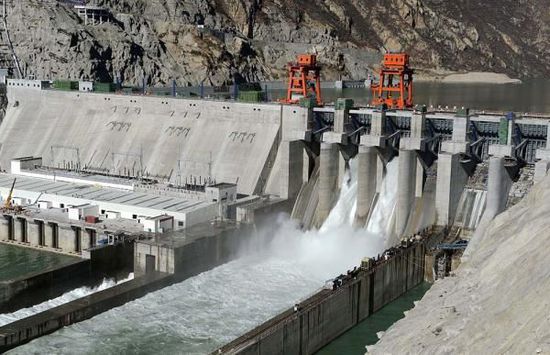 |
|
Tibet's largest hydropower station on the Yarlung Zangbo River become partly operational, in Gyaca county, Shannan Prefecture on Sunday. [Photo/Xinhua] |
One of the six power units in Tibet's largest hydropower station began operating on Sunday and started to ease concerns over power shortages in the autonomous region, Tibet Subsiary of electric utility group China Huaneng Group said.
The Zam Hydropower Station is considered the world's highest-altitude hydropower station and the largest of its kind in Tibet. It has raised installed capacity from 100,000 kilowatts to the present 510,000 kilowatts in the region.
The first power units is located at an elevation of more than 3,300 meters on the "roof of the world" and cost 9.6 billion yuan ($1.5 billion). The other units are expected to be put into use by next year.
The project was launched in 2007 and each of its power units can generate 85,000 kilowatts, with all six units producing an annual 2.5 billion kilowatts of electricity, officials from the Tibet Subsidiary of China Huaneng Group said.
"The full completion of the project by the end of August 2015 can be a great gift to mark the 50th anniversary of the founding of the Tibet autonomous region next year," said Ding Yexian, the executive vice-chairman of the region.
"For environmental protection and ecological conservation, we have maintained facilities such as waterways for fish, sewage treatment plants and recycling spots at the project sites," said Zhang Tingke, vice-president of the Tibet Subsidiary of the China Huaneng Group.
"In the past, with only a small-scaled power station in our county, villagers there had no electricity during the winter. They also had to use generators to supplement power in the summer," said Gonchog Dorje, Party secretary of Tibet's Gyatsa county.
Mimar Tsamjo, a villager living near the hydropower station, said the project has helped to improve their livelihood.
"We will no longer have to suffer from power shortages and our villagers will begin to operate oil-pressing mills in the village as we have stable electricity," Mimar Tsamjo said.
"The project has not only benefited villagers with its stable power, it has also provided many of them with jobs," she said.
By the end of Oct 2014, Tibet's capacitance reached to 1.48 million kilowatts, and the first operation of Zam Hydropower Station will account one third of the Tibet's total capacitance.
